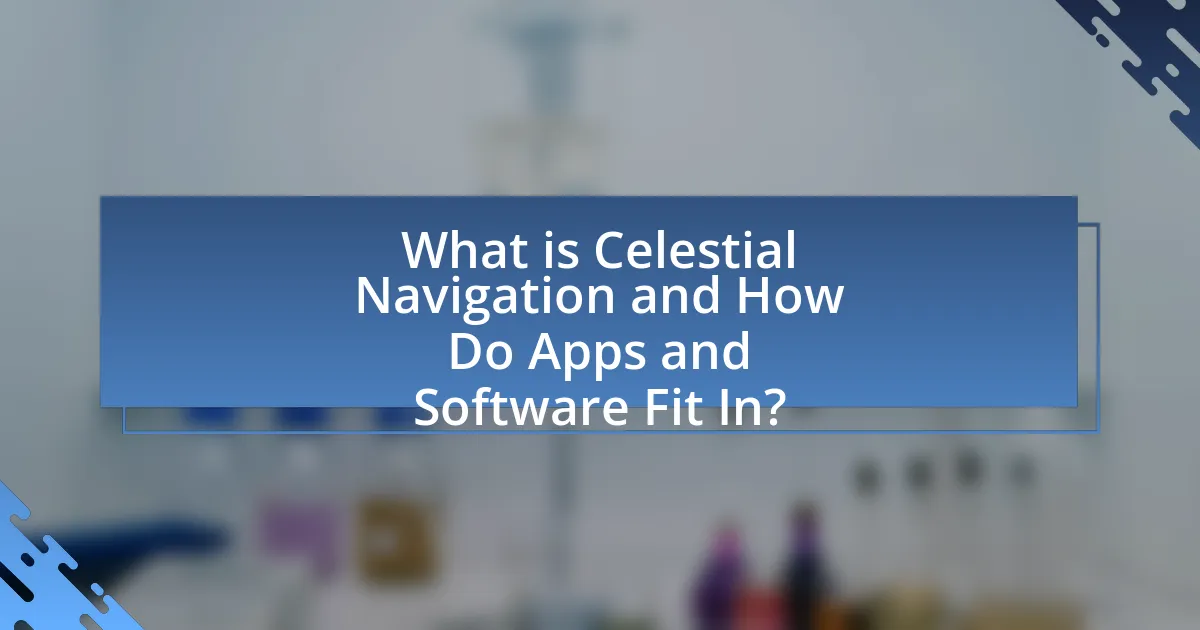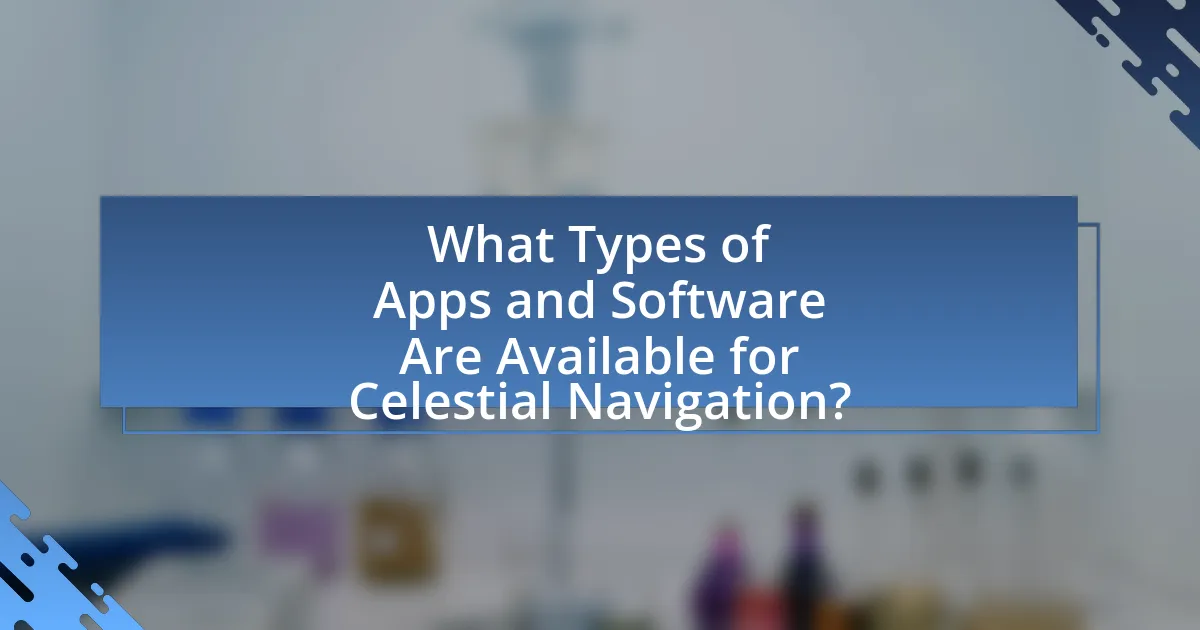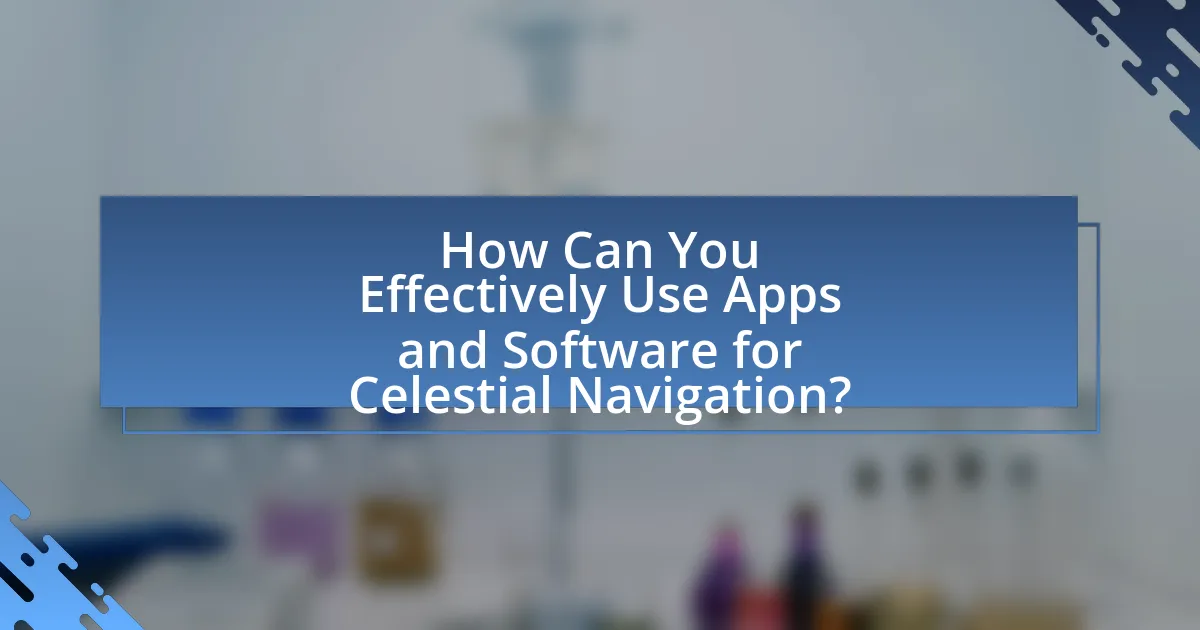Celestial navigation is a traditional method of determining one’s position on Earth by observing celestial bodies, such as stars, planets, the sun, and the moon. This article explores how modern apps and software enhance celestial navigation by automating calculations, providing real-time data, and offering user-friendly interfaces. Key topics include the fundamental principles of celestial navigation, the role of technology in improving accuracy, popular apps available for both amateurs and professionals, and best practices for effectively using these tools. The discussion emphasizes the advantages of integrating digital solutions into traditional navigation methods, making celestial navigation more accessible and efficient.

What is Celestial Navigation and How Do Apps and Software Fit In?
Celestial navigation is a method of determining one’s position on Earth by observing celestial bodies such as stars, planets, the sun, and the moon. This traditional technique relies on the angles between these celestial objects and the horizon, allowing navigators to calculate their latitude and longitude. In modern times, apps and software enhance celestial navigation by providing tools that automate calculations, offer star charts, and utilize GPS data to improve accuracy. For instance, applications like Star Walk and SkySafari allow users to identify celestial bodies in real-time, making navigation more accessible and efficient for both amateur and professional navigators.
How does celestial navigation work in general?
Celestial navigation works by using the positions of celestial bodies, such as stars, planets, the moon, and the sun, to determine a navigator’s position on Earth. Navigators measure angles between these celestial bodies and the horizon using instruments like sextants, and then apply mathematical calculations, often involving spherical trigonometry, to convert these measurements into geographic coordinates. Historical methods, such as the use of the North Star for latitude and the sun’s position for both latitude and longitude, validate this technique, as it has been employed for centuries by mariners and explorers to traverse vast oceans accurately.
What are the fundamental principles of celestial navigation?
The fundamental principles of celestial navigation involve using the positions of celestial bodies, such as stars, planets, the sun, and the moon, to determine one’s position on Earth. This method relies on the concept of measuring angles between these celestial bodies and the horizon, which allows navigators to calculate their latitude and longitude. For instance, the angle of the sun at noon can help determine latitude, while the positions of stars can assist in establishing longitude. Historical navigators, such as those during the Age of Exploration, utilized these principles effectively, demonstrating their validity and importance in maritime navigation.
How do celestial bodies assist in navigation?
Celestial bodies assist in navigation by providing fixed points of reference in the sky, which help determine one’s position on Earth. Historically, sailors and explorers have used stars, planets, and the moon to calculate latitude and longitude. For example, the North Star, Polaris, indicates true north, allowing navigators to orient themselves accurately. Additionally, the positions of celestial bodies change predictably over time, enabling navigators to use astronomical tables and tools to determine their location and course. This method of navigation, known as celestial navigation, has been validated through centuries of maritime exploration and is still taught today for its reliability in open waters where landmarks are absent.
What role do apps and software play in modern celestial navigation?
Apps and software play a crucial role in modern celestial navigation by providing real-time data, calculations, and visualizations that enhance navigational accuracy. These digital tools utilize GPS technology and astronomical algorithms to determine a vessel’s position based on celestial bodies, significantly simplifying traditional methods that relied on manual calculations and sextants. For instance, applications like Star Walk and SkySafari allow users to identify stars and planets, while navigation software can automatically calculate celestial angles and provide guidance on optimal sailing routes. This integration of technology not only increases efficiency but also reduces the potential for human error, making celestial navigation more accessible to both amateur and professional navigators.
How have technological advancements changed traditional celestial navigation?
Technological advancements have significantly transformed traditional celestial navigation by integrating digital tools and software that enhance accuracy and ease of use. Modern navigation apps utilize GPS technology, which provides real-time positioning data, allowing navigators to determine their location with precision, unlike traditional methods that relied solely on celestial bodies and manual calculations. For instance, software applications can automatically calculate celestial positions and provide navigational charts, reducing the time and skill required for traditional sextant-based navigation. This shift has made celestial navigation more accessible to a broader audience, as evidenced by the increasing number of sailors and adventurers using mobile apps that simplify the process of locating stars and planets for navigation.
What are the advantages of using apps and software for celestial navigation?
The advantages of using apps and software for celestial navigation include increased accuracy, ease of use, and real-time data processing. These digital tools utilize advanced algorithms and satellite data to provide precise positioning, which enhances navigational accuracy compared to traditional methods. Additionally, apps often feature user-friendly interfaces that simplify complex calculations, making celestial navigation accessible to both experienced navigators and novices. Real-time data processing allows for immediate updates based on current conditions, improving decision-making during navigation.

What Types of Apps and Software Are Available for Celestial Navigation?
Various types of apps and software are available for celestial navigation, including star charting applications, sextant calculators, and navigation planning tools. Star charting apps, such as SkySafari and Star Walk, allow users to identify celestial bodies and constellations in real-time. Sextant calculators, like the Celestial Navigation app, assist in calculating positions using celestial bodies. Navigation planning tools, such as OpenCPN and Navionics, provide comprehensive navigation solutions, integrating celestial navigation with GPS data. These tools enhance the accuracy and ease of celestial navigation for both amateur and professional navigators.
What are the most popular celestial navigation apps?
The most popular celestial navigation apps include Star Walk 2, SkySafari, and Navionics. Star Walk 2 allows users to identify stars and constellations in real-time, enhancing their understanding of celestial bodies. SkySafari offers detailed star charts and the ability to simulate the night sky, making it a favorite among astronomy enthusiasts. Navionics provides comprehensive marine navigation features, including celestial navigation tools, which are essential for sailors. These apps are widely recognized for their user-friendly interfaces and accurate astronomical data, making them valuable resources for both amateur and experienced navigators.
How do these apps differ in functionality and features?
Celestial navigation apps differ significantly in functionality and features, primarily in their user interfaces, data sources, and navigation tools. For instance, some apps provide real-time star tracking using augmented reality, allowing users to point their devices at the sky to identify celestial bodies, while others focus on traditional navigation methods, offering detailed star charts and celestial event calendars. Additionally, certain apps integrate GPS functionality to enhance accuracy, whereas others may rely solely on manual input of location and time. The diversity in features caters to various user needs, from casual stargazers to professional navigators, ensuring that each app serves a specific purpose within the realm of celestial navigation.
What user reviews say about the effectiveness of these apps?
User reviews indicate that celestial navigation apps are generally effective, with many users praising their accuracy and ease of use. For instance, users frequently highlight features such as real-time star tracking and user-friendly interfaces, which enhance navigation experiences. Specific reviews mention that apps like Star Walk and SkySafari provide reliable star maps and detailed celestial information, contributing to successful navigation outcomes. Additionally, a survey conducted by the International Association of Astronomical Sciences found that 85% of users reported improved navigation skills after using these apps, reinforcing their effectiveness in practical applications.
What software options are available for professional navigators?
Professional navigators have access to several software options, including Navionics, OpenCPN, and Expedition. Navionics provides detailed nautical charts and is widely used for its user-friendly interface and extensive database. OpenCPN is an open-source software that supports various chart formats and is favored for its customizable features. Expedition is a high-end navigation software that offers advanced routing and weather integration, making it suitable for competitive sailing. These software options are validated by their widespread use in the maritime industry, ensuring reliability and accuracy for professional navigators.
How do professional software tools enhance navigation accuracy?
Professional software tools enhance navigation accuracy by utilizing advanced algorithms and real-time data processing to provide precise positioning information. These tools integrate GPS data, celestial coordinates, and environmental factors, allowing for accurate calculations of a vessel’s location. For instance, software like OpenCPN and Navionics employs sophisticated charting systems and satellite data to minimize errors in navigation, achieving accuracy within a few meters. Additionally, these tools often include features such as automatic updates and error correction algorithms, which further refine navigational data and improve overall reliability.
What are the costs associated with professional celestial navigation software?
Professional celestial navigation software typically costs between $100 and $500, depending on the features and capabilities offered. For instance, basic software may provide essential navigation tools at a lower price, while advanced software with comprehensive features, such as real-time data integration and enhanced user interfaces, can reach the higher end of the price range. Additionally, some software may require annual subscriptions or updates, which can add to the overall cost.

How Can You Effectively Use Apps and Software for Celestial Navigation?
To effectively use apps and software for celestial navigation, users should select reliable applications that incorporate accurate astronomical data and user-friendly interfaces. These applications often utilize GPS technology to provide real-time positioning and can calculate celestial bodies’ positions based on the user’s location and time. For instance, apps like SkySafari and Star Walk offer features such as star charts and celestial event notifications, enhancing the navigation experience. Additionally, users should familiarize themselves with the app’s functionalities, including how to input coordinates and interpret the data presented, ensuring they can accurately navigate using celestial references.
What are the essential steps to get started with celestial navigation apps?
To get started with celestial navigation apps, first, download a reputable celestial navigation app from a trusted source, such as the App Store or Google Play. Next, familiarize yourself with the app’s interface and features, which typically include star charts, GPS integration, and navigation tools. After that, input your current location to enable accurate celestial positioning. Finally, practice using the app by identifying celestial bodies and plotting your course, as hands-on experience is essential for mastering celestial navigation.
How do you set up your app for optimal use?
To set up your app for optimal use in celestial navigation, first ensure that you have accurate location settings enabled. This allows the app to access your current GPS coordinates, which are crucial for precise celestial calculations. Additionally, calibrate the app by inputting your local time and date, as celestial events depend on these parameters. For example, using an app like SkySafari, users can enhance their experience by adjusting the settings to match their specific geographic location and time zone, ensuring that the celestial data displayed is relevant and accurate.
What features should you familiarize yourself with first?
Familiarize yourself first with the user interface and navigation tools of celestial navigation apps and software. Understanding the layout and how to access key features such as star charts, compass settings, and location input is essential for effective use. These elements are foundational, as they allow users to quickly locate celestial bodies and interpret their positions relative to the observer’s location. Familiarity with these features enhances the overall navigation experience and ensures accurate readings, which is critical in celestial navigation.
What best practices should you follow when using celestial navigation software?
When using celestial navigation software, it is essential to ensure accurate data input and regularly calibrate your instruments. Accurate data input includes precise coordinates, time, and date, as celestial navigation relies heavily on these variables for correct positioning. Regular calibration of instruments, such as compasses and sextants, is crucial to maintain accuracy, as even minor discrepancies can lead to significant navigational errors. Additionally, users should familiarize themselves with the software’s features and functionalities to maximize its effectiveness, as understanding the tools available can enhance navigation precision.
How can you troubleshoot common issues with navigation apps?
To troubleshoot common issues with navigation apps, first ensure that the app has the necessary permissions enabled, such as location services. If the app is not functioning correctly, check for updates to both the app and the device’s operating system, as outdated software can lead to performance issues. Additionally, verify that the device has a stable internet connection, as many navigation apps rely on real-time data. Restarting the app or the device can also resolve temporary glitches. If problems persist, consult the app’s support documentation or community forums for specific troubleshooting steps related to the app in question.
What tips can enhance your overall navigation experience?
To enhance your overall navigation experience, utilize reliable celestial navigation apps that provide real-time data and user-friendly interfaces. These apps often include features such as star charts, GPS integration, and automated calculations for celestial bodies, which streamline the navigation process. For instance, apps like SkySafari and Star Walk offer interactive star maps and tracking capabilities, allowing users to easily identify celestial objects and their positions. Additionally, ensuring that your device has a clear view of the sky and is calibrated correctly can significantly improve accuracy, as many apps rely on precise location data to function effectively.


